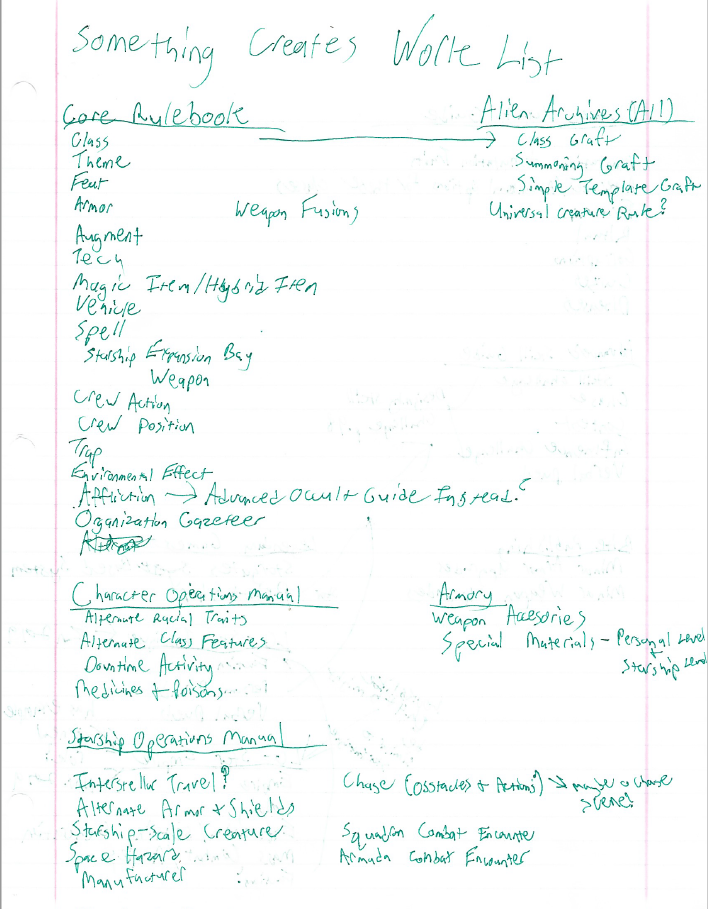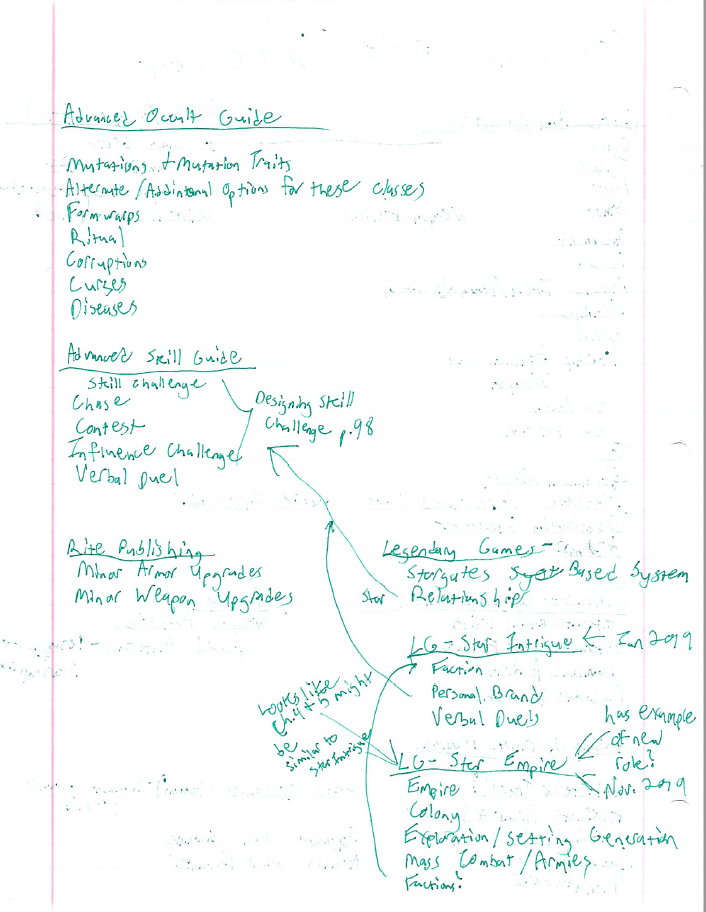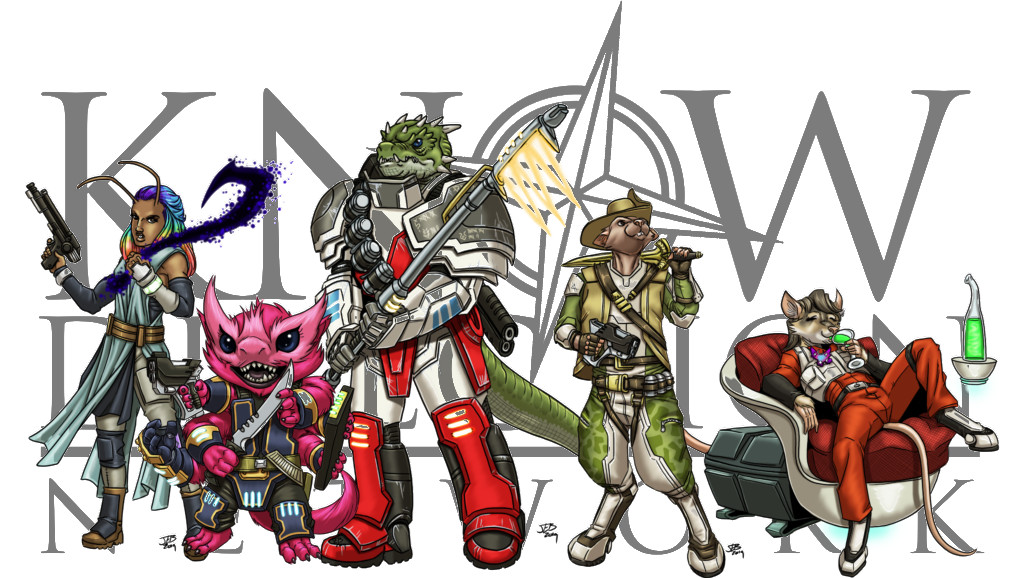Introduction
Well, well. This was the first blog that I didn’t have a plan for months ago. I despaired a little bit that I had worked my way through the “basic” beginner design spaces for Starfinder. When my head was in that space, I started to look at some 3rd Party design space that I know exists, particularly Corruptions from the Advanced Occult Guide, published by Rogue Genius Games & Everybody Games (NOTE: Alex and Owen have no idea I was considering or anything). Before I got started though, I came up with the idea to open up the Starfinder Core Rulebook’s table of contents, and simply list the things that I had yet to design.

Wow! I could not have been more wrong about being “out” of stuff to design. If you take a look at the image that I’ve shared for today’s post, you’ll see that I came up with not just a healthy list of things to design that Paizo has created space for, but I’ve also taken a look at a few of the 3rd Party Products that I own and discovered more space to explore there as well! Now, this list is biased in the fact that it’s only material I own so the only publishers I took a look at are Rogue Genius Games, Everybody Games, Rite Publishing, and Legendary Games. I do feel though, that these 4 publishers probably make up a substantial piece of the Starfinder 3rd Party Publisher pie.
Unfortunately, when I went to start putting together my post about Corruptions this weekend, I discovered that the rules aren’t publicly available on OGL sites like starjammersrd.com. I know I don’t want to design something that I can’t showcase the base rules system on, so while I investigate ways to legally showcase the Corruption ruleset (and other 3rd Party Publisher rulesets) that’s released under the OGL and Starfinder Compatibility License, I figured I’d have to work on something else.
That something else is going to be Themes!
What Makes a Theme?
A theme is arguably one of the more straightforward design spaces in Starfinder. It obviously arose from the Trait system in Pathfinder 1st Edition. It provides some of the answers to “Who are you?” for Player Characters. It can also help answer “Where did you come from?”, but not to the extent that a Pathfinder 2nd Edition’s background does in my opinion. A Theme is something a character is throughout a campaign. Whereas a Background in 2E is purely where you have been.
Themes have a number of things in common, that we can cover right now:
- A 1st Level Ability that typically provides a particular skill as a class skill, or a +1 bonus to that skill
- This ability also lowers the DC by 5 for some version of Recall Knowledge utilizing the skill you’ve been granted a bonus/access to.
- A 6th Level Ability that isn’t normally directly useful in combat, but does provide some interesting benefits. Ideally this ability will lead to interesting story-telling when you utilize this ability
- A 12th & 18th Level Abilities. These are a bit more varied from theme to theme, especially as you move further away from the Core Rulebook in publication date.
One thing that I’ll want to keep in mind while designing a theme, is that most published material, and therefore published play doesn’t go beyond 12th level (with the exception of Devastation Ark). Whatever I end up designing, I know I’ll want the Theme Knowledge ability at 1st level, and the 6th level ability to be really evocative of the theme. I want a Player Character feels as though they are the theme by the time they’re 6th level.
Finding a Theme Niche
I do think that Paizo has published enough themes to cover most players, there is still plenty of space to explore. There are definitely archetypes that cover the study of magic, if the Scholar theme doesn’t quite fit what you’re looking for a mystical scholar that focuses on the theory (but maybe not the application?) of magic is absent as far as I can tell.
Broad, career type themes are important to be able to live out certain tropes or fantasies, but in my opinion Themes and Background truly come alive when they are applied directly to the setting that you’re playing in. The Solar Disciple & Tempered Pilgrim are some of my favorite themes because they’re tied to the setting (not so much that you can’t file off serial numbers though!)
With that in mind, I have started to think more about the Setting that my Thurinag and Cosmic Combine reside in. I could start filling in my setting as I need it. That is a tried and true approach. But months ago, fellow KD contributor, Randal Myers, and I discussed the possibility of my using the setting that he was building in his Terraforming series. Now, I’m not making any promises, but it could be neat to collaborate with Randal and place Thurinag and the Cosmic Combine into that setting. I need to do a deep dive to see if what he was building is what I’m looking for! If not, that’s okay too. I’ll just have more questions I’ll need to answer as I’m designing a theme or two!
Conclusion
While I went into this expecting to design a neat corruption to throw at my players in Fly Free or Die in the future, I found myself getting excited about building a theme or two. I don’t know if I’m excited for the themes themselves, or the fact that by designing a theme, it might force me to think a bit more about the setting that I’m designing in. In the moves made by Paizo at the end of Pathfinder 1st Edition, and made in Pathfinder 2nd Edition, they firmly believe that designing with a setting in mind adds something to the process. I’m a believer in that too. As long as I can remember, I’ve always been a player/GM that flocks to setting focused material, whether its 3.5 Forgotten Realms, the Lost Omens setting, or the Pact Worlds setting. With that in mind, I think I’m excited to begin angling my own work more towards a setting to hopefully inspire interesting design choices in the future!




